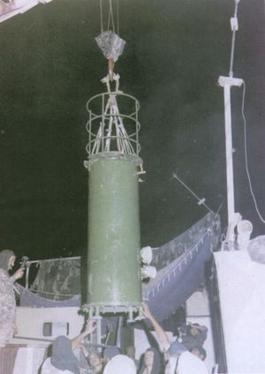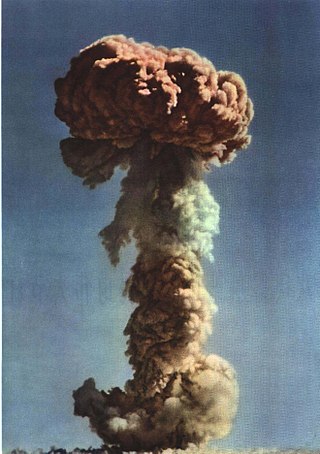
Nuclear weapons tests are experiments carried out to determine the performance, yield, and effects of nuclear weapons. Testing nuclear weapons offers practical information about how the weapons function, how detonations are affected by different conditions, and how personnel, structures, and equipment are affected when subjected to nuclear explosions. However, nuclear testing has often been used as an indicator of scientific and military strength. Many tests have been overtly political in their intention; most nuclear weapons states publicly declared their nuclear status through a nuclear test.

Qian Xuesen was a Chinese aerospace engineer and cyberneticist who made significant contributions to the field of aerodynamics and established engineering cybernetics. He achieved recognition as one of America's leading experts in rockets and high-speed flight theory prior to his returning to China in 1955.

The nuclear arms race was an arms race competition for supremacy in nuclear warfare between the United States, the Soviet Union, and their respective allies during the Cold War. During this same period, in addition to the American and Soviet nuclear stockpiles, other countries developed nuclear weapons, though no other country engaged in warhead production on nearly the same scale as the two superpowers.

The People's Republic of China has developed and possesses weapons of mass destruction, including chemical and nuclear weapons. The first of China's nuclear weapons tests took place in 1964, and its first hydrogen bomb test occurred in 1966 at Lop Nur. Tests continued until 1996, when the country signed the Comprehensive Nuclear-Test-Ban Treaty (CTBT), but did not ratify it. China acceded to the Biological Weapons Convention (BWC) in 1984 and ratified the Chemical Weapons Convention (CWC) in 1997. Since 2020, China has been wielding a nuclear triad, alongside four other countries.

Zhou Guangzhao was a Chinese theoretical physicist who served as President of the Chinese Academy of Sciences from 1987 to 1997.

The T-7 was China's first sounding rocket. A test rocket, dubbed the T-7M, was first successfully launched on 19 February 1960 in Nanhui, Shanghai, and a full-scale rocket was launched on 13 September 1960. Wang Xiji of the Shanghai Institute of Mechanical and Electrical Engineering was the chief designer. Twenty-four T-7 rockets were launched between 1960 and 1965, and it was retired after a final launch in 1969.

Pokhran-II was a series of five nuclear weapon tests conducted by India in May 1998. The bombs were detonated at the Indian Army's Pokhran Test Range in Rajasthan. It was the second instance of nuclear testing conducted by India, after the first test, code-named Smiling Buddha, was conducted in May 1974.

Qian Sanqiang, also known as Tsien San-Tsiang, was a Chinese nuclear physicist and among the leading scientists of the Two Bombs, One Satellite program. Due to his central role in the development of China's nuclear industry and nuclear weapons program, he is referred to as the "father of China's atomic bomb". Coincidentally, China's first atomic bomb test was conducted on Qian's 51st birthday.

Project 596 was the first nuclear weapons test conducted by the People's Republic of China, detonated on 16 October 1964, at the Lop Nur test site. It was a uranium-235 implosion fission device made from weapons-grade uranium (U-235) enriched in a gaseous diffusion plant in Lanzhou.

Test No. 6 is the codename for China's first test of a three-staged thermonuclear device and, also its sixth nuclear weapons test. It was a part of the "Two Bombs, One Satellite" program.

Deng Jiaxian, also spelled as Chia-Hsien Teng, was a Chinese theoretical physicist, nuclear physicist, member of the Chinese Academy of Sciences, member of the 12th Central Committee of the Chinese Communist Party, and member of the Central Committee of the Jiusan Society. Deng Jiaxian graduated from the National Southwestern Associated University of the Republic of China, then went to the United States to study, and received a doctorate in physics from Purdue University in 1950. Deng Jiaxian made significant contributions to the development of the atomic bomb of the People's Republic of China and was honored as the "Patriot of the Two Bombs". In 1999, he was named the "Patron of the Two Bombs and One Star" by the Chinese government.

Cheng Kaijia, also known as Kai Chia Cheng, was a Chinese nuclear engineer and nuclear physicist. He was a pioneer and key figure in Chinese nuclear weapon development. He is known as one of the founding fathers of Two Bombs, One Satellite.

Zhu Guangya was a Chinese nuclear physicist. Zhu Guangya was noted for his dedication to the Chinese nuclear development, and his great devotion to his country.
China Academy of Engineering Physics (CAEP) was founded in October 1958. The CAEP is China's main organization conducting the research, development, and testing of nuclear weapons and related science.

Yu Min was a prominent Chinese nuclear physicist. He was an academic of Chinese Academy of Sciences (CAS), a lead nuclear weapon designer in the Ninth Academy, and a recipient of Two Bombs, One Satellite Achievement Medal. Though he personally refused to accept the title, he is honored as “the father of [the] Chinese Hydrogen Bomb”.

Chen Nengkuan, or N. K. Chen, was a Chinese metallurgist and material scientist. He was an academician of the Chinese Academy of Sciences and one of the 23 founding fathers of China's Two Bombs, One Satellite (两弹一星元勋).

Ren Xinmin was a Chinese aerospace engineer and a specialist in astronautics and liquid rocket engine technology. He was the technical director of the Long March 1 rocket, which launched the Dong Fang Hong I, China's first satellite, and the chief designer of Chinese storable propellant rocket engine. He was also the chief designer for the Long March 3 launch vehicle, Fengyun, and SJ (Shijian) series satellites.
Yang Jiachi was a Chinese aerospace engineer and a specialist in satellite control and automation. A participant in the development of China's first satellites and the developer of the attitude control system for recoverable satellites, he was awarded the Two Bombs, One Satellite Meritorious Medal in 1999. He was an academician of the Chinese Academy of Sciences and the International Academy of Astronautics. The asteroid 11637 Yangjiachi is named after him.



















